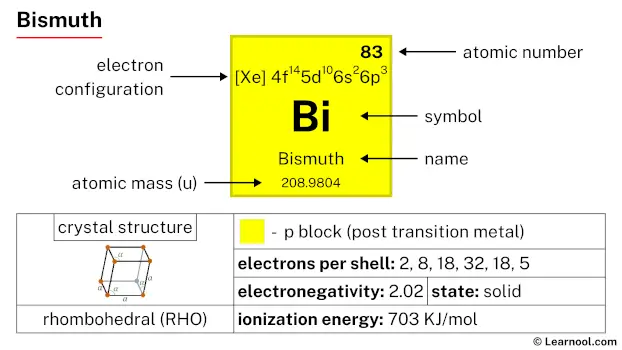
Bismuth (Bi) is a chemical element of the periodic table, located in the group 15 and the period 6, and has the atomic number 83. It is a brittle, silvery-pink post transition metal, whose name comes from the German word “wissmuth”, which means white mass. It is a member of the pnictogen group.
On periodic table
| group | ⇨ | 1 | 2 | 3 | 4 | 5 | 6 | 7 | 8 | 9 | 10 | 11 | 12 | 13 | 14 | 15 | 16 | 17 | 18 |
| period | ⇩ | ||||||||||||||||||
| 1 | 1 H 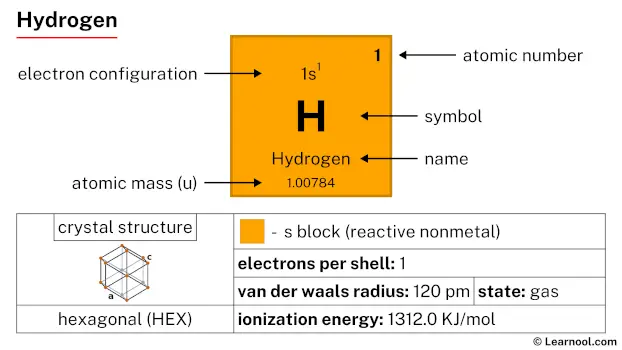 Hydrogen |
2 He  Helium |
|||||||||||||||||
| 2 | 3 Li  Lithium |
4 Be 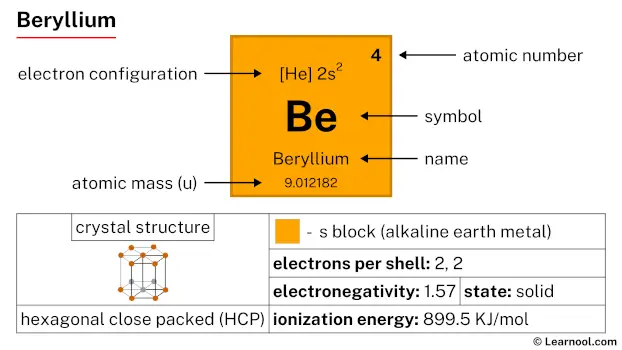 Beryllium |
5 B 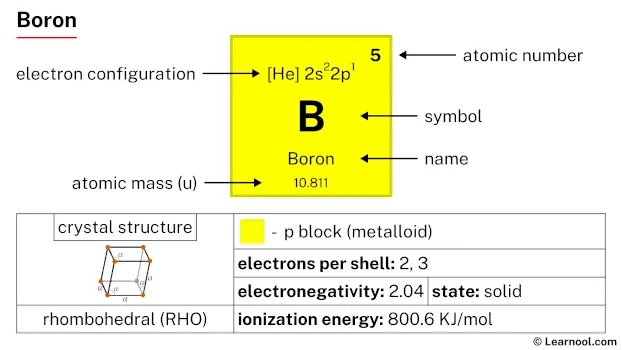 Boron |
6 C  Carbon |
7 N 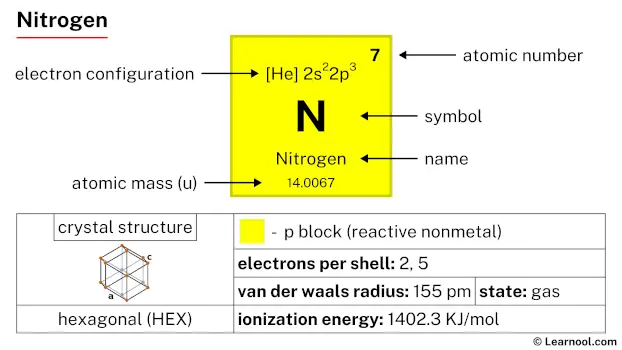 Nitrogen |
8 O 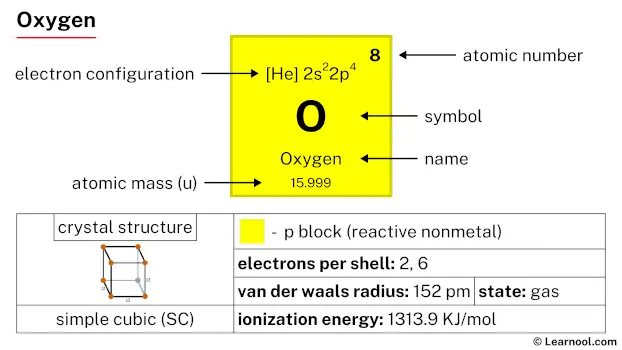 Oxygen |
9 F 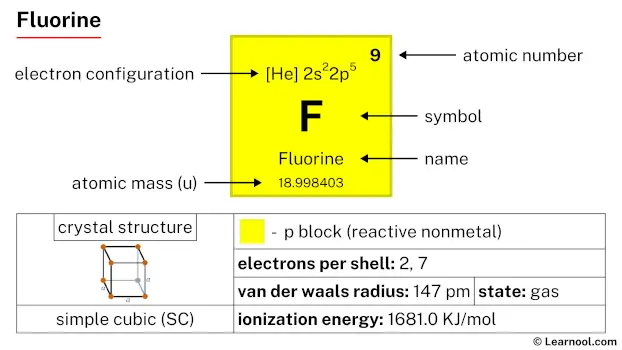 Fluorine |
10 Ne 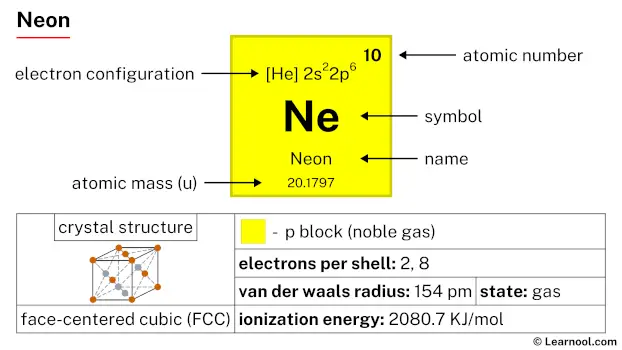 Neon |
|||||||||||
| 3 | 11 Na 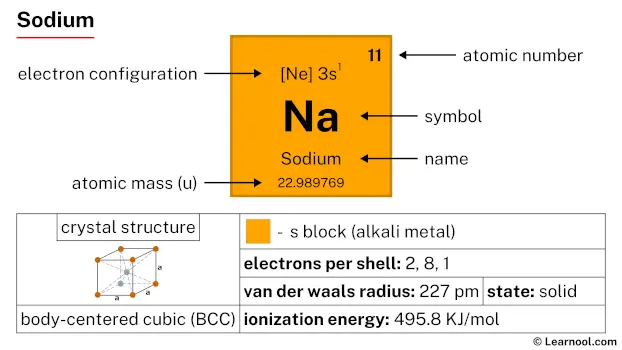 Sodium |
12 Mg 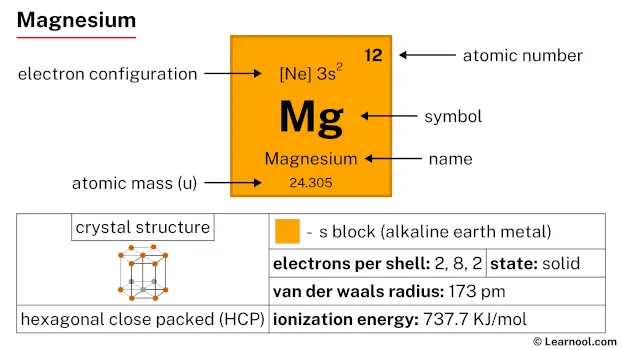 Magnesium |
13 Al  Aluminium |
14 Si Silicon |
15 P 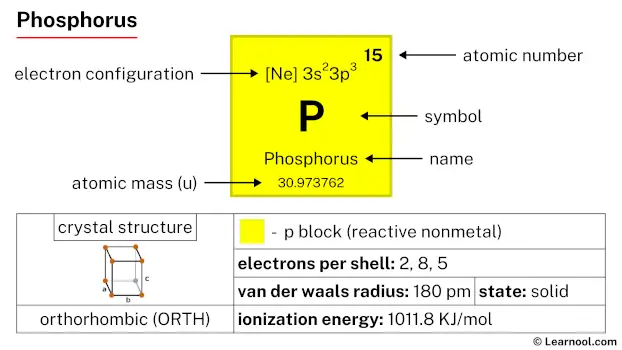 Phosphorus |
16 S 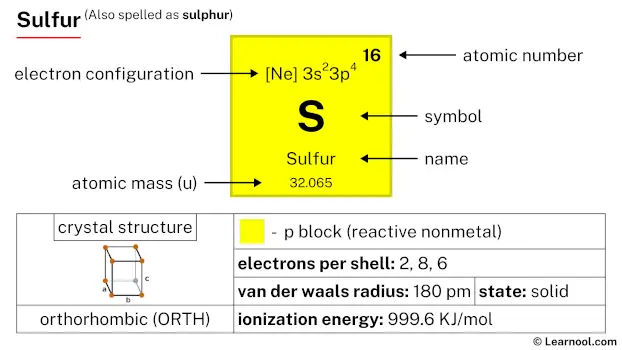 Sulfur |
17 Cl 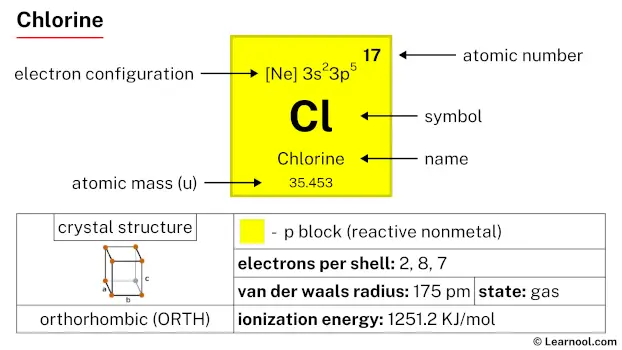 Chlorine |
18 Ar 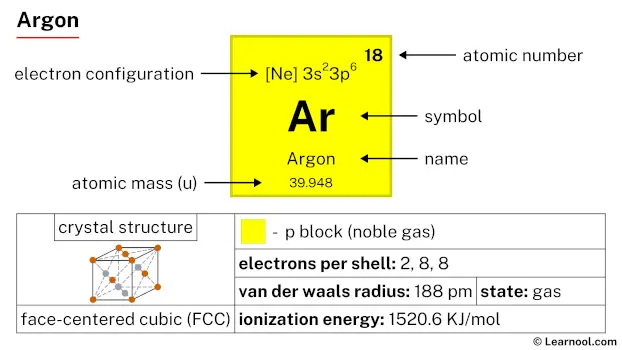 Argon |
|||||||||||
| 4 | 19 K 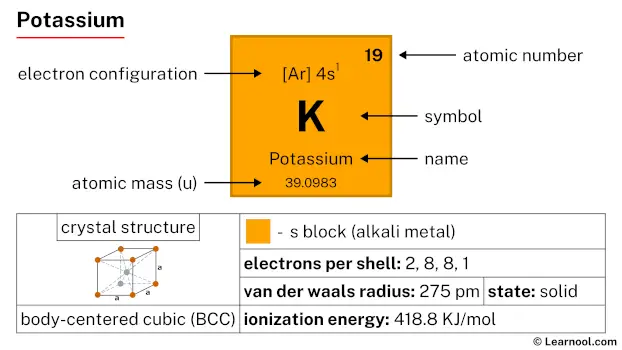 Potassium |
20 Ca 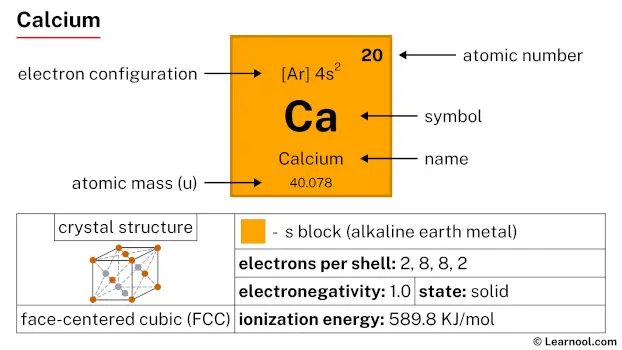 Calcium |
21 Sc 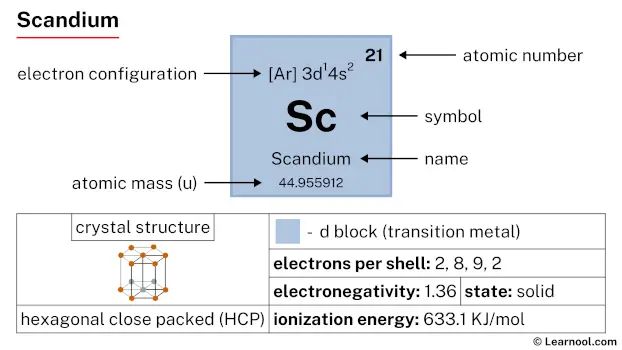 Scandium |
22 Ti 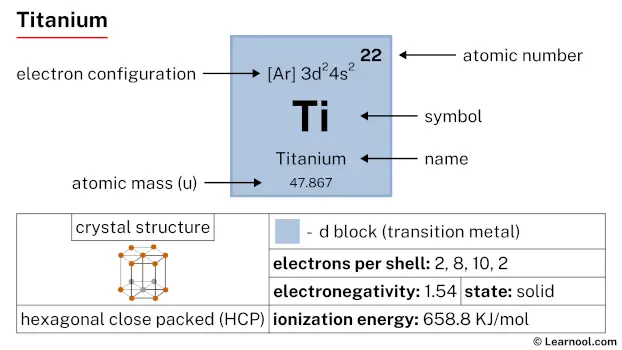 Titanium |
23 V 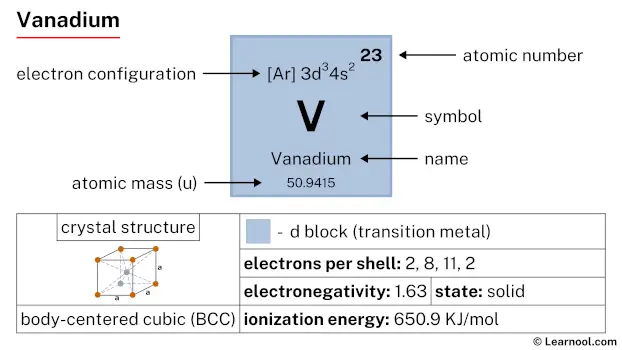 Vanadium |
24 Cr 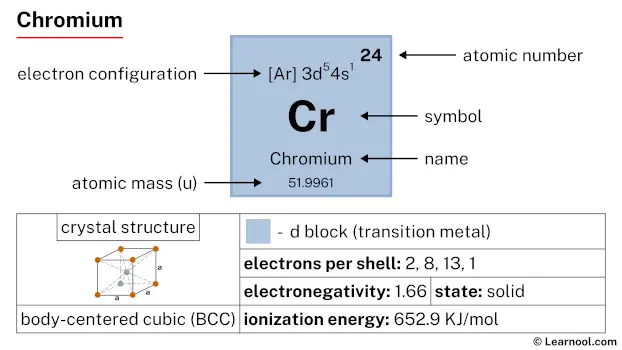 Chromium |
25 Mn 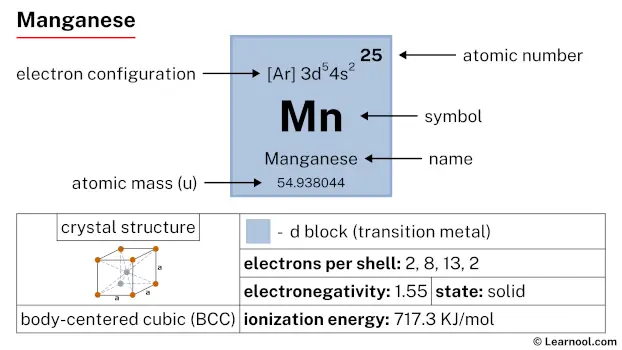 Manganese |
26 Fe 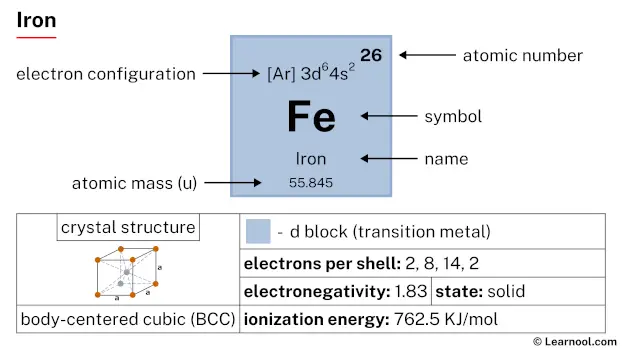 Iron |
27 Co 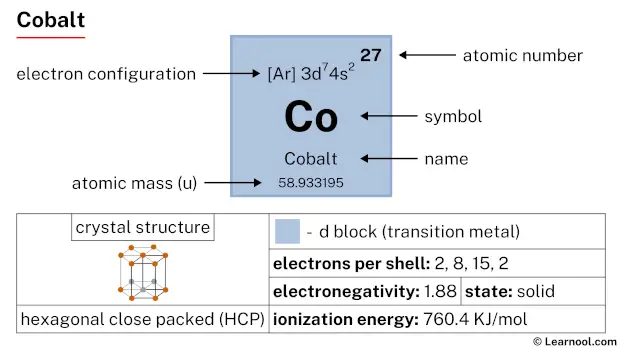 Cobalt |
28 Ni 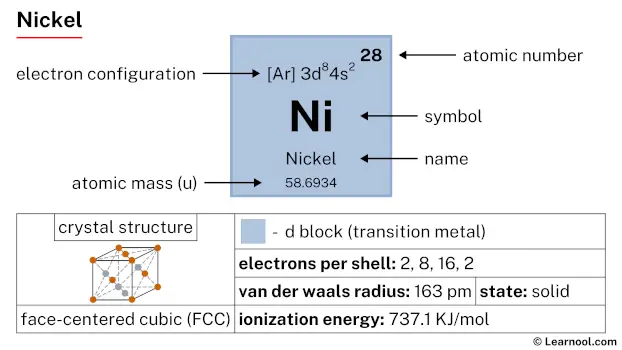 Nickel |
29 Cu 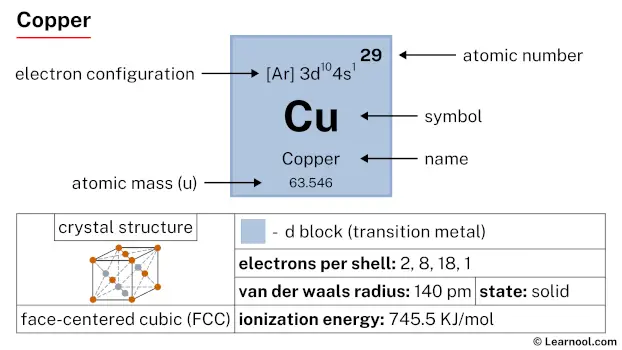 Copper |
30 Zn  Zinc |
31 Ga 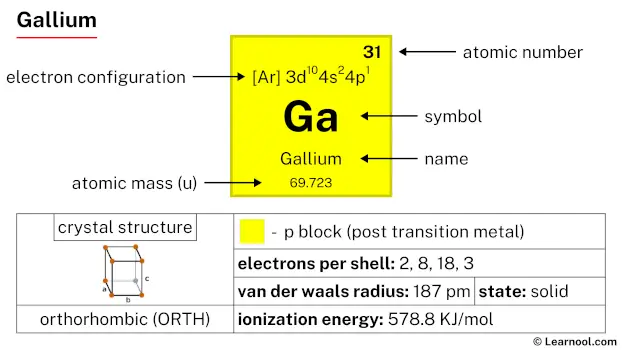 Gallium |
32 Ge 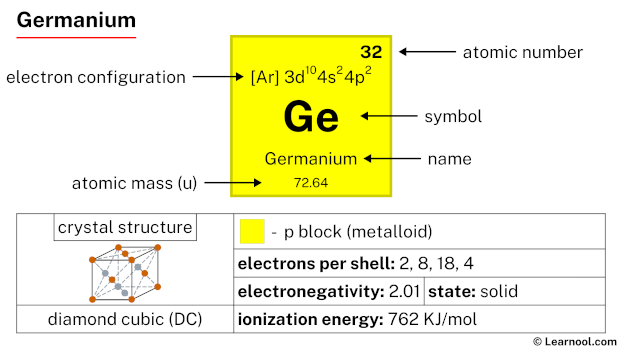 Germanium |
33 As 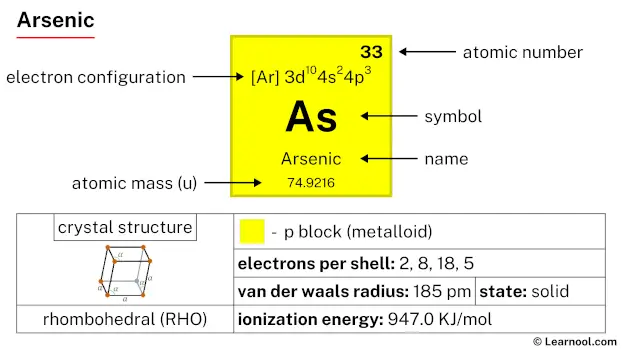 Arsenic |
34 Se 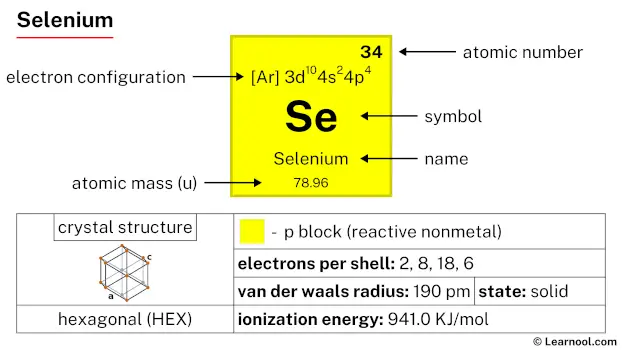 Selenium |
35 Br 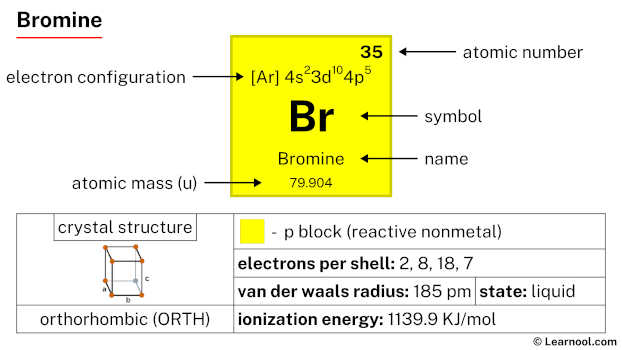 Bromine |
36 Kr  Krypton |
|
| 5 | 37 Rb 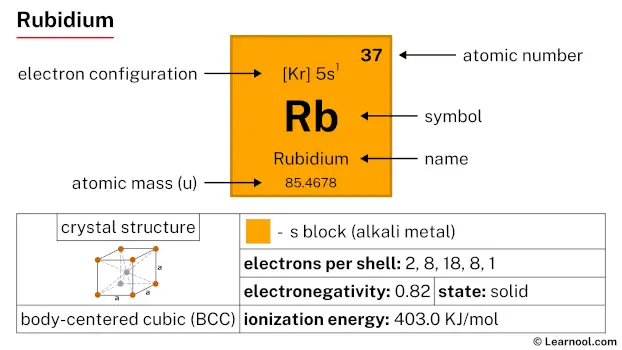 Rubidium |
38 Sr 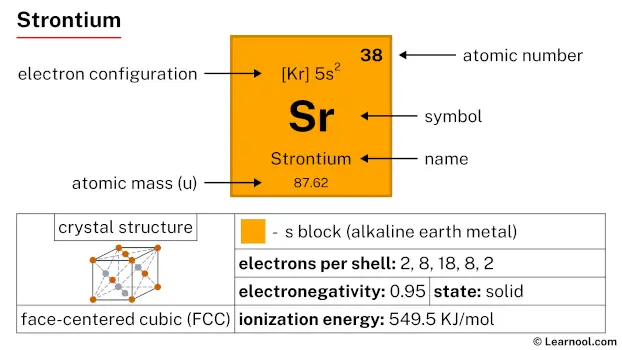 Strontium |
39 Y 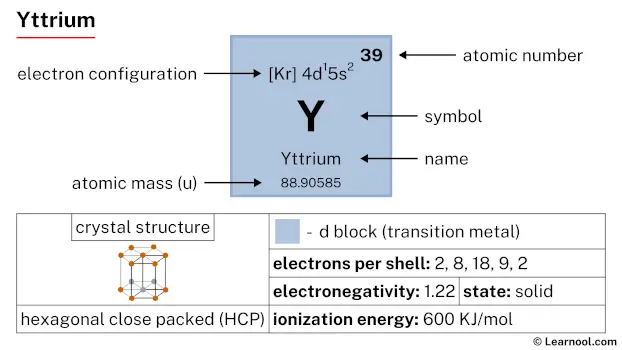 Yttrium |
40 Zr 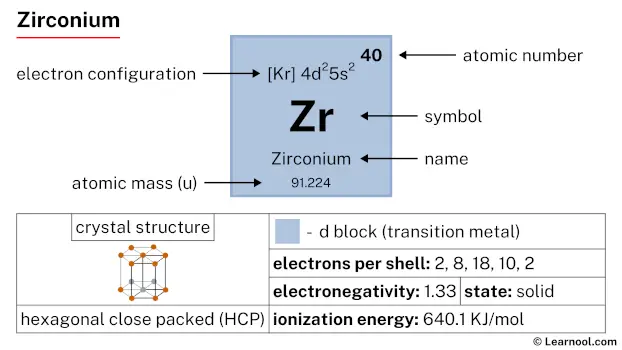 Zirconium |
41 Nb 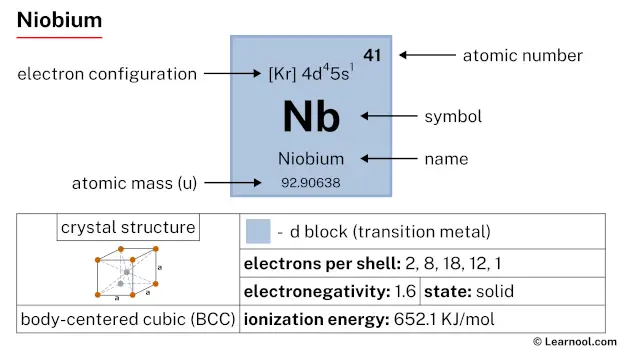 Niobium |
42 Mo 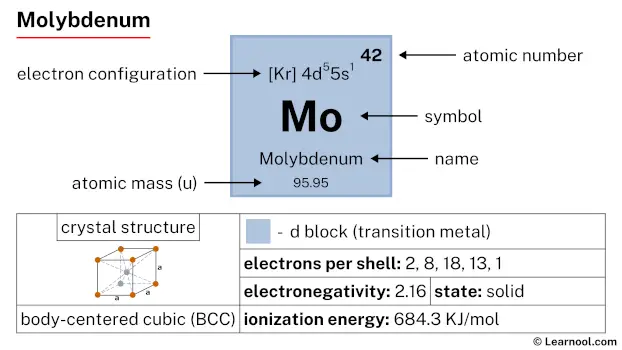 Molybdenum |
43 Tc 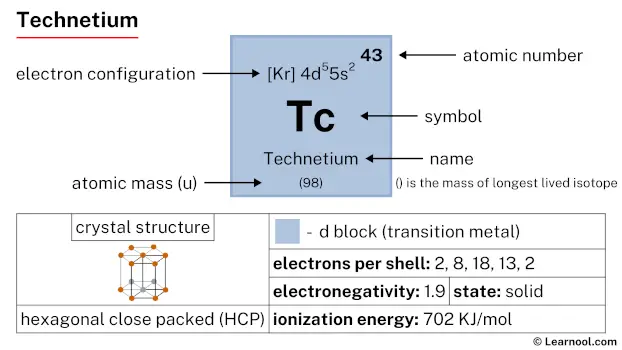 Technetium |
44 Ru 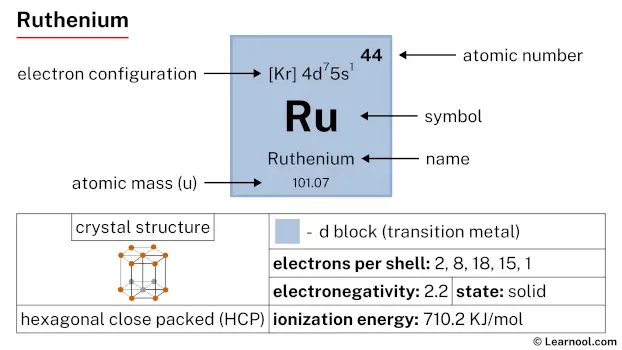 Ruthenium |
45 Rh 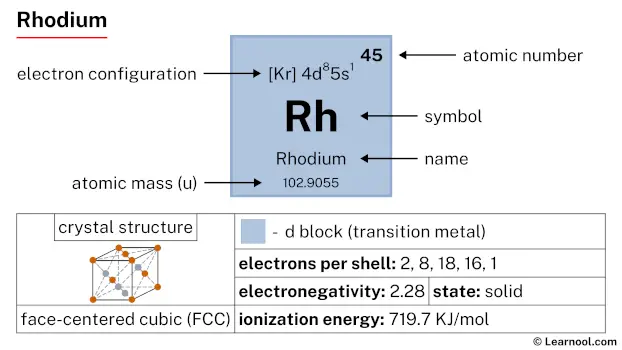 Rhodium |
46 Pd  Palladium |
47 Ag  Silver |
48 Cd 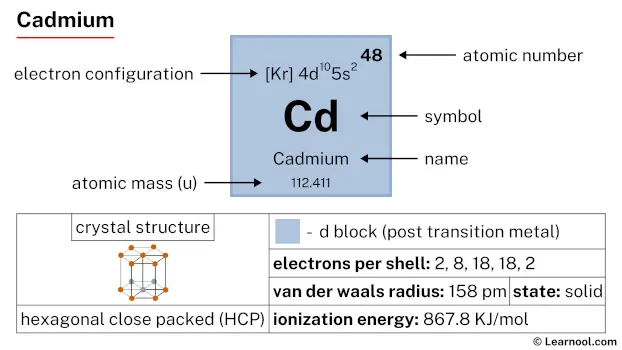 Cadmium |
49 In 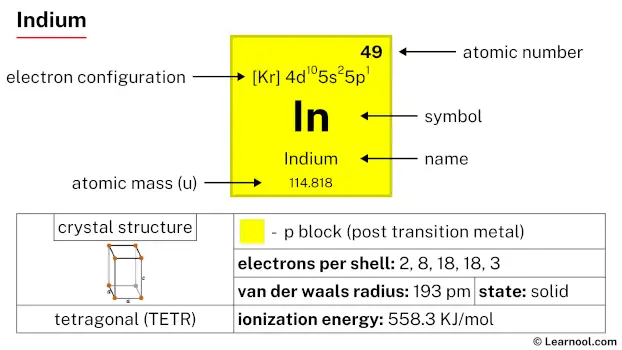 Indium |
50 Sn 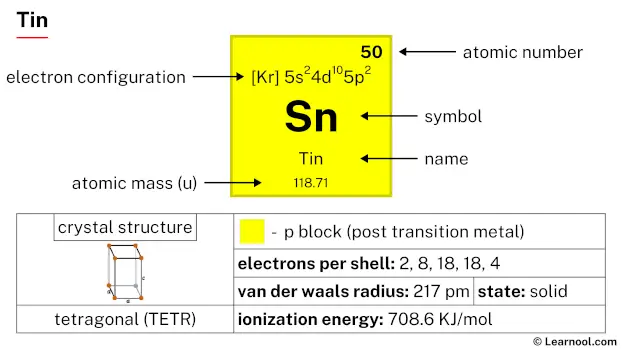 Tin |
51 Sb 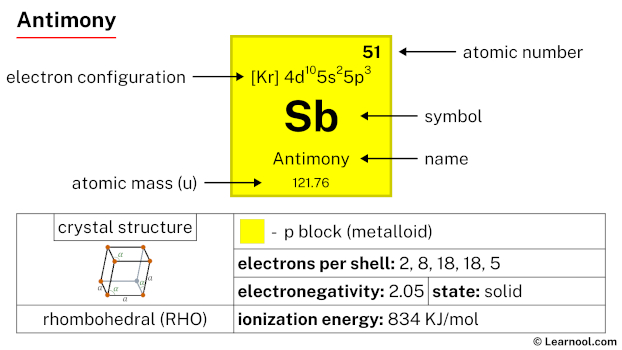 Antimony |
52 Te 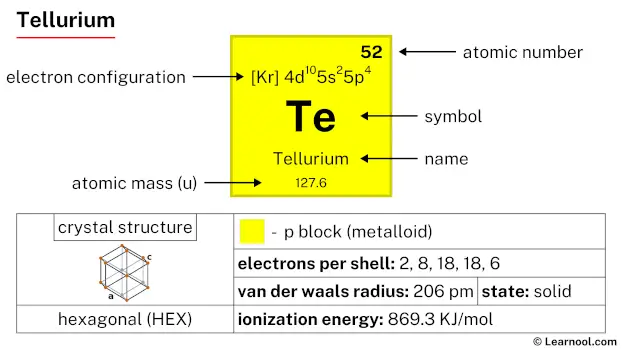 Tellurium |
53 I 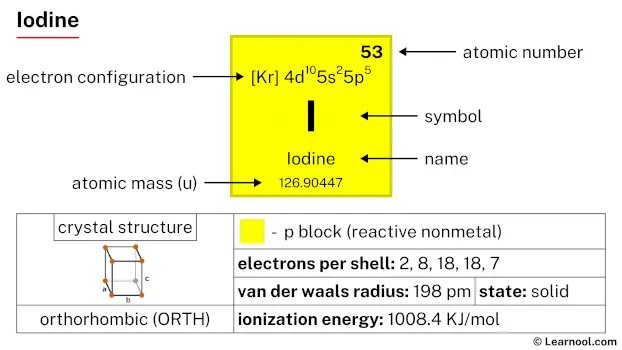 Iodine |
54 Xe 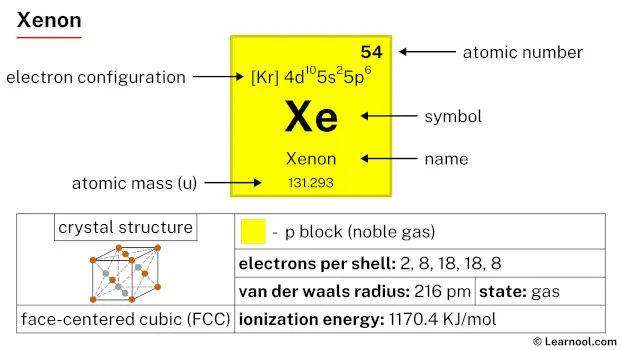 Xenon |
|
| 6 | 55 Cs 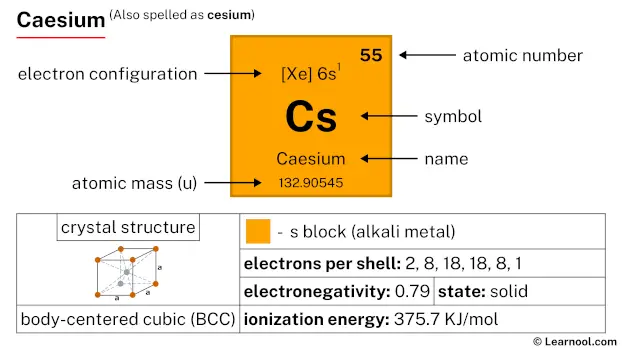 Caesium |
56 Ba 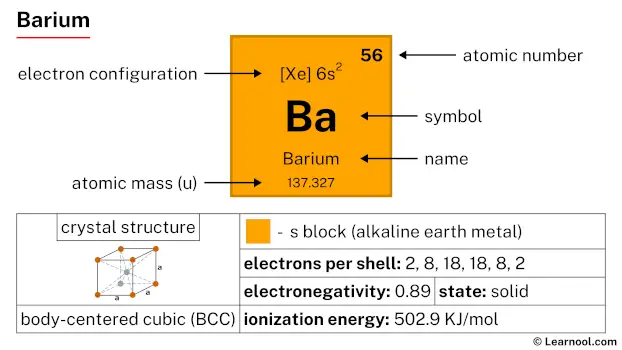 Barium |
72 Hf 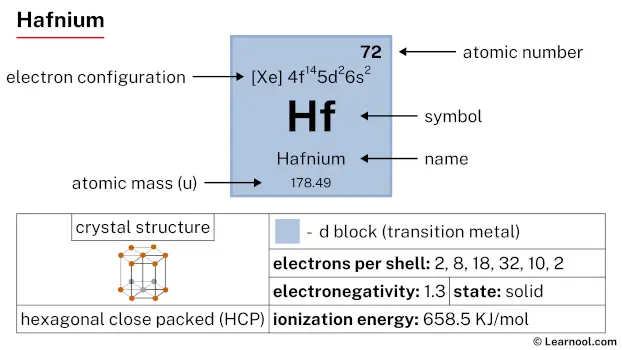 Hafnium |
73 Ta 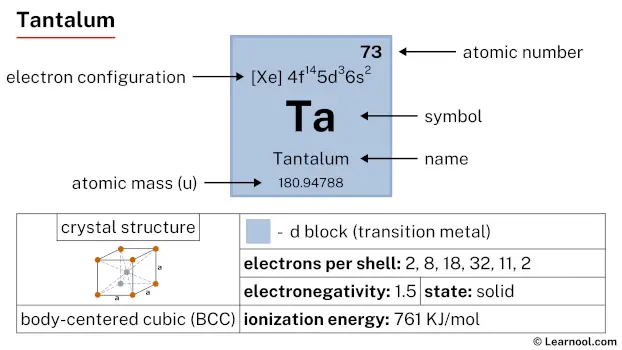 Tantalum |
74 W 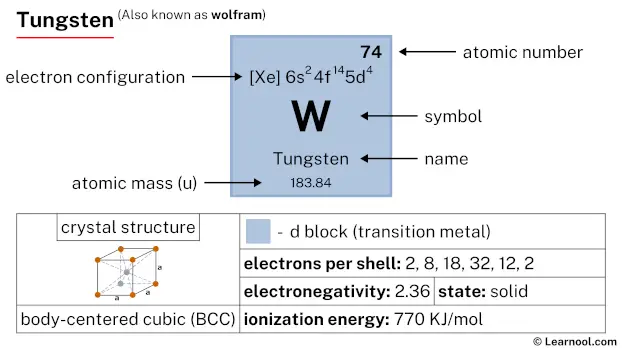 Tungsten |
75 Re 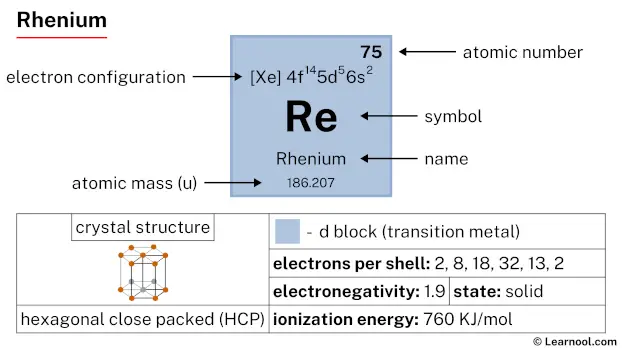 Rhenium |
76 Os 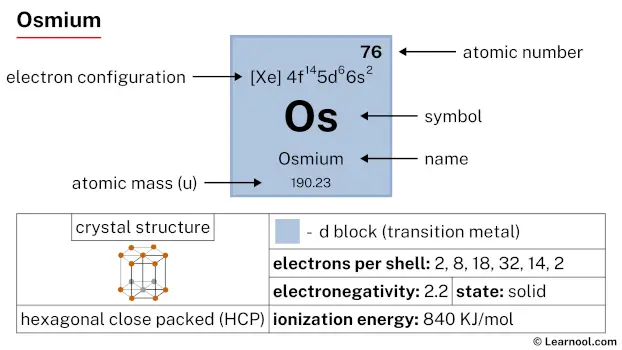 Osmium |
77 Ir 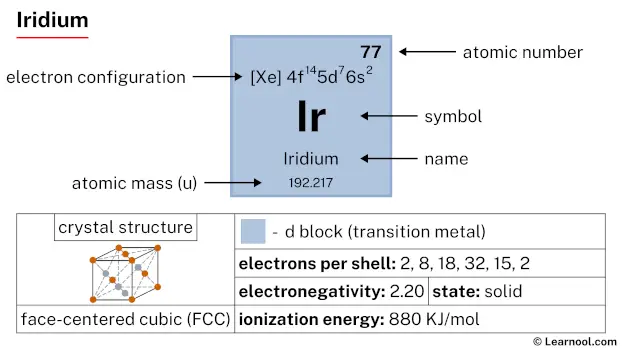 Iridium |
78 Pt  Platinum |
79 Au  Gold |
80 Hg 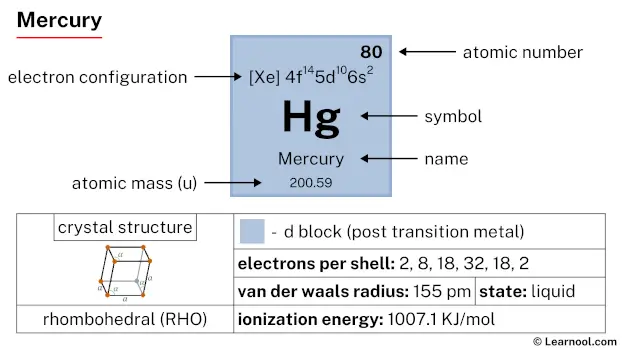 Mercury |
81 Tl 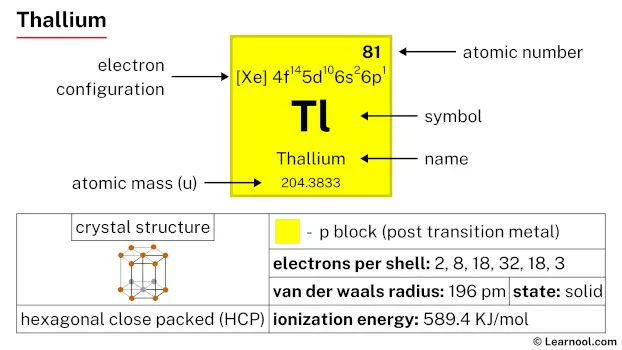 Thallium |
82 Pb  Lead |
83 Bi Bismuth |
84 Po 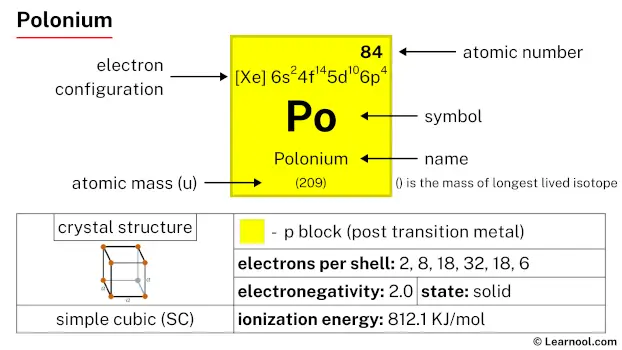 Polonium |
85 At 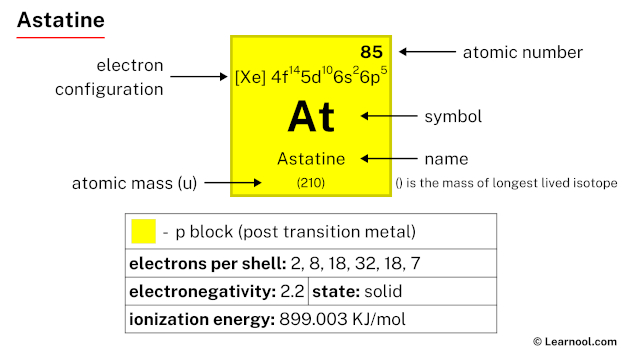 Astatine |
86 Rn 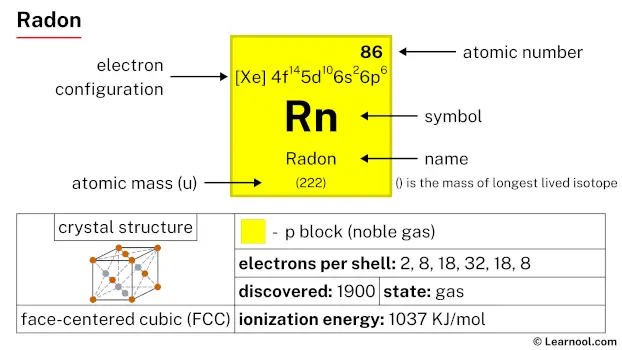 Radon |
||
| 7 | 87 Fr 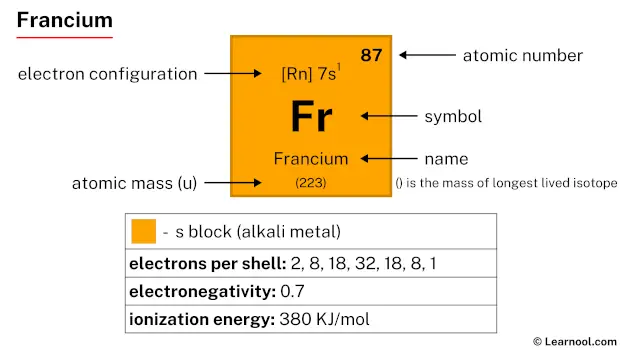 Francium |
88 Ra 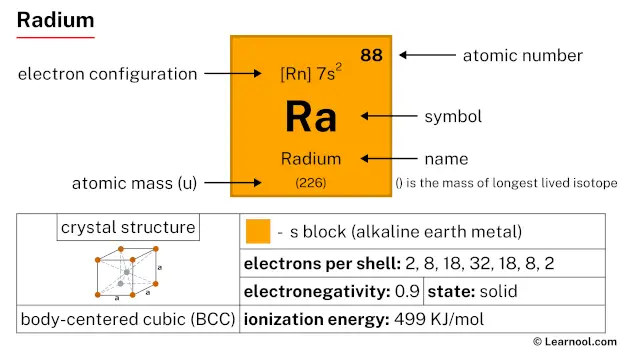 Radium |
104 Rf 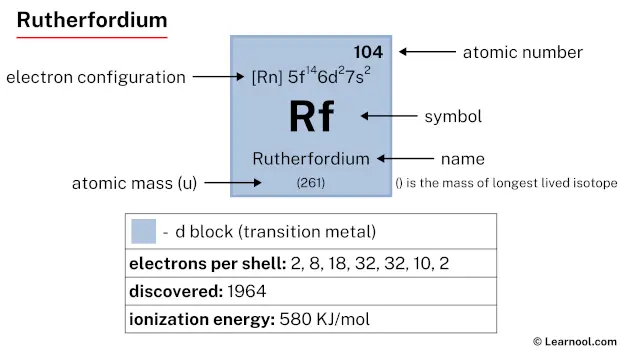 Rutherfordium |
105 Db 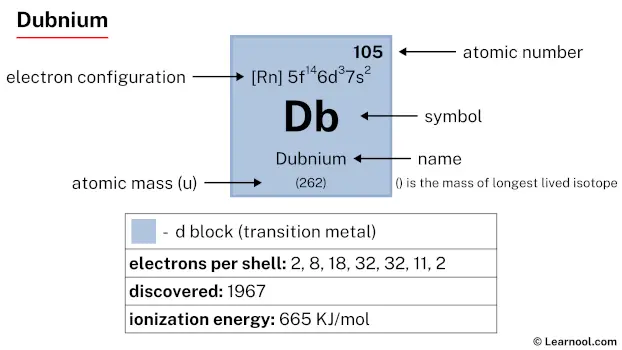 Dubnium |
106 Sg 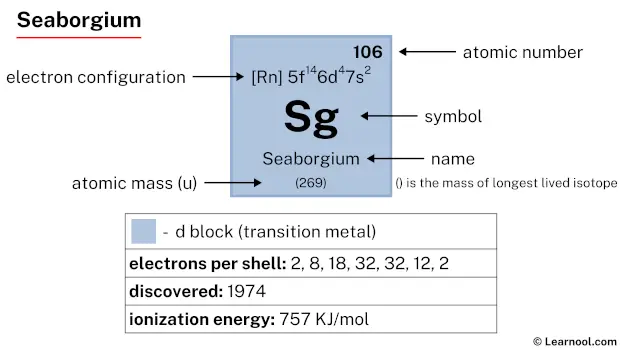 Seaborgium |
107 Bh 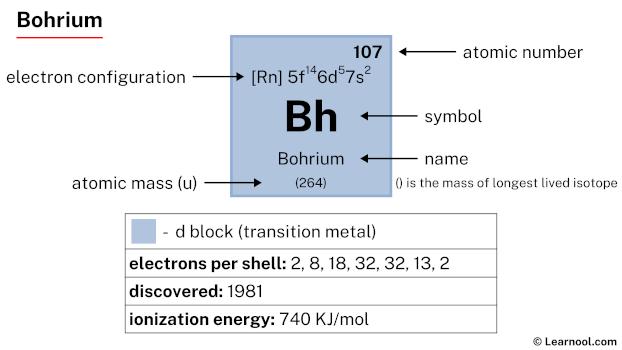 Bohrium |
108 Hs 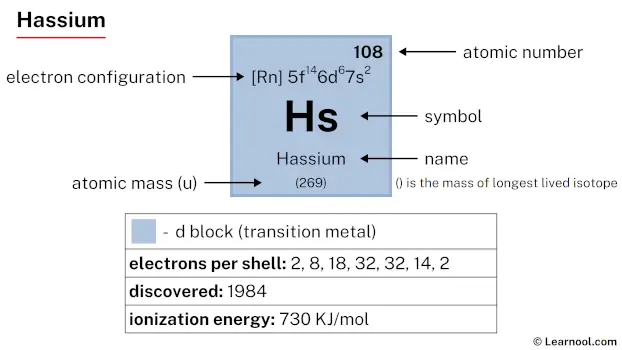 Hassium |
109 Mt 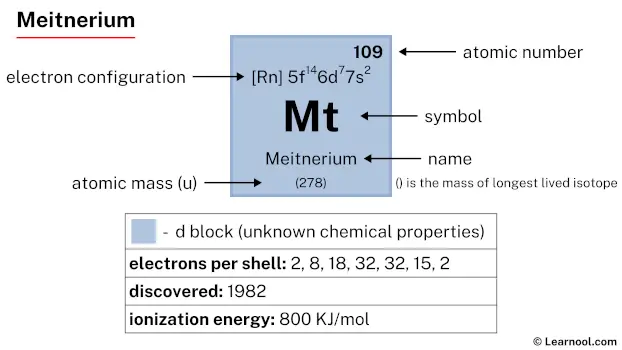 Meitnerium |
110 Ds 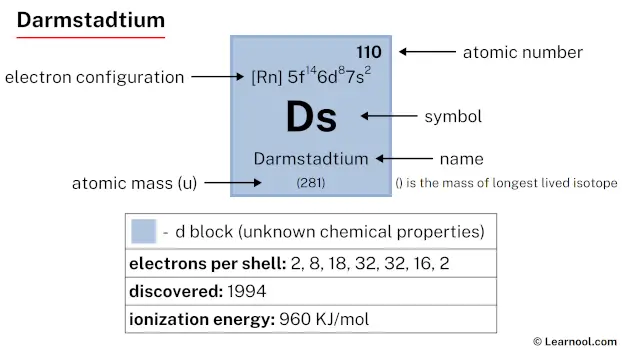 Darmstadtium |
111 Rg 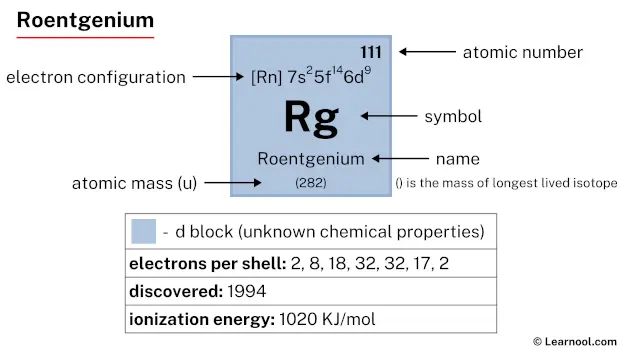 Roentgenium |
112 Cn  Copernicium |
113 Nh 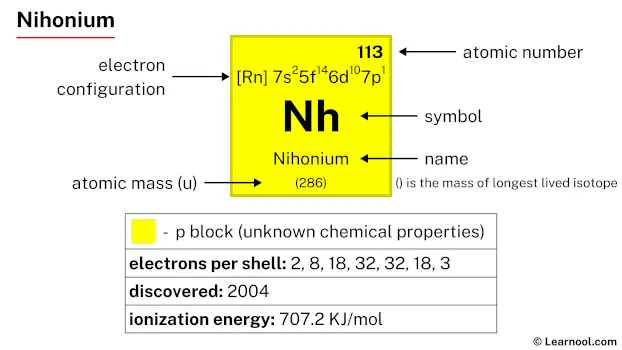 Nihonium |
114 Fl 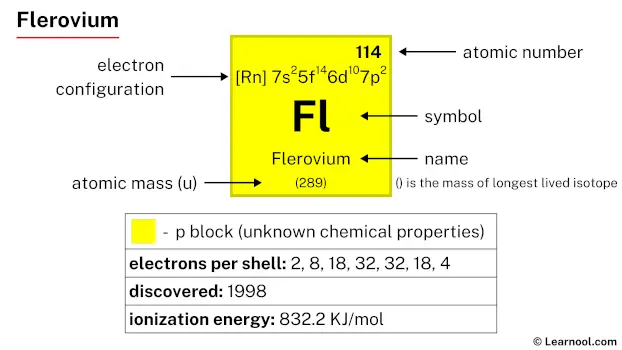 Flerovium |
115 Mc 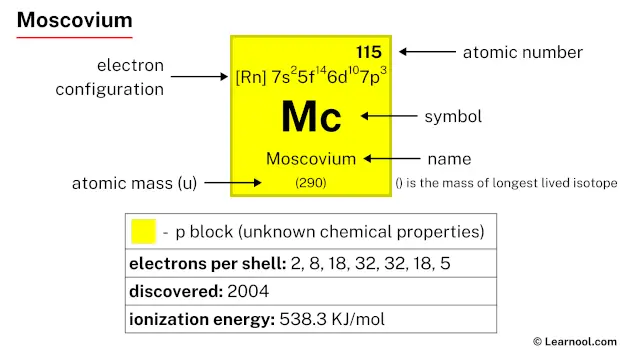 Moscovium |
116 Lv 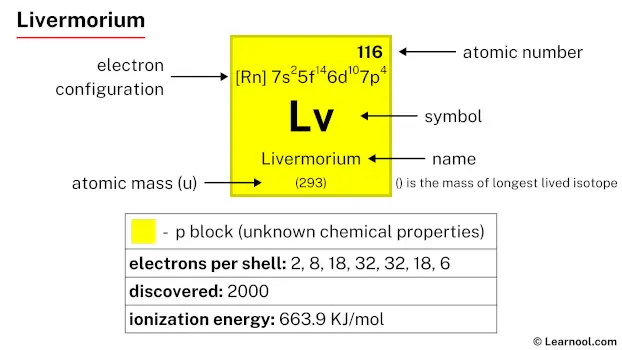 Livermorium |
117 Ts 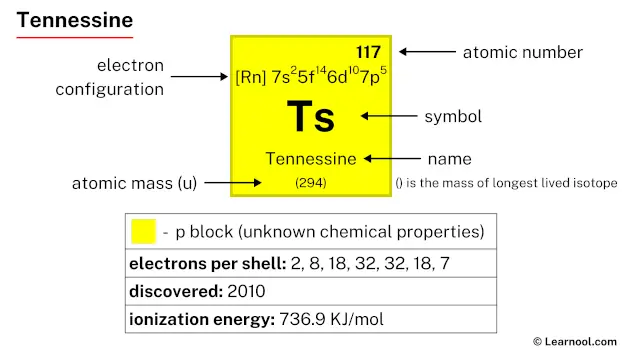 Tennessine |
118 Og 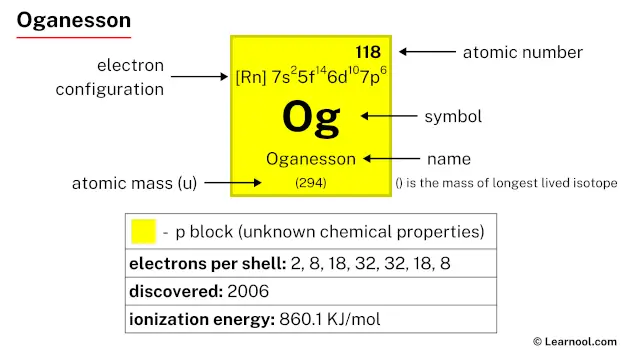 Oganesson |
||
| 57 La 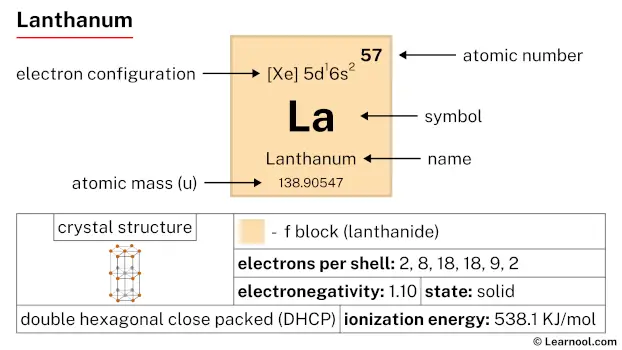 Lanthanum |
58 Ce 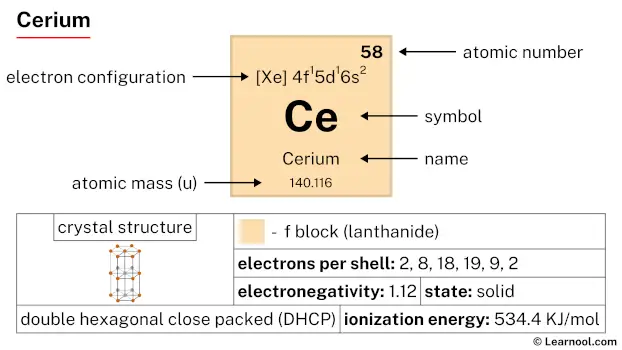 Cerium |
59 Pr 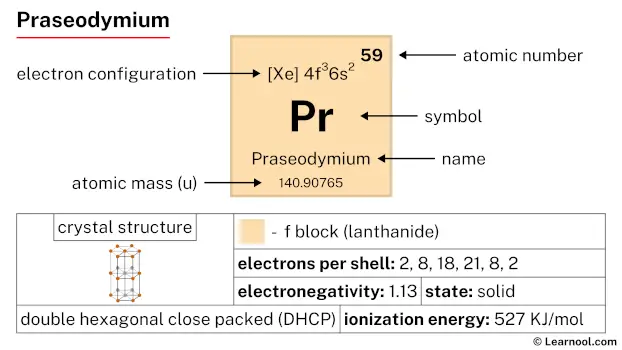 Praseodymium |
60 Nd 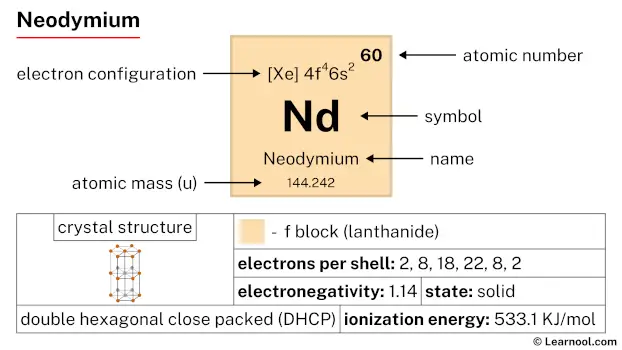 Neodymium |
61 Pm 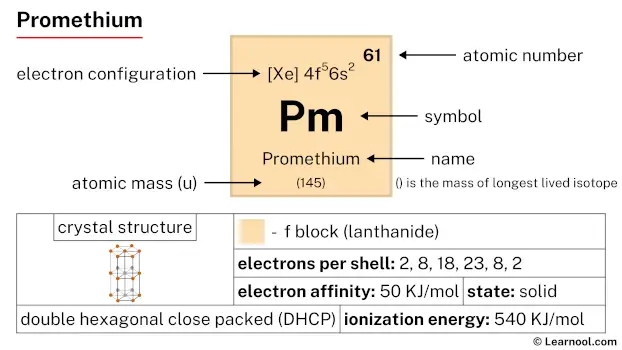 Promethium |
62 Sm 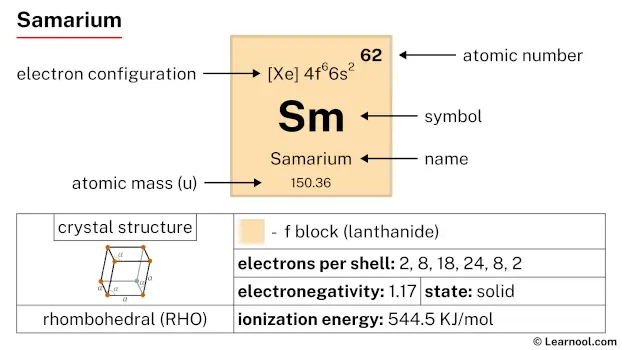 Samarium |
63 Eu 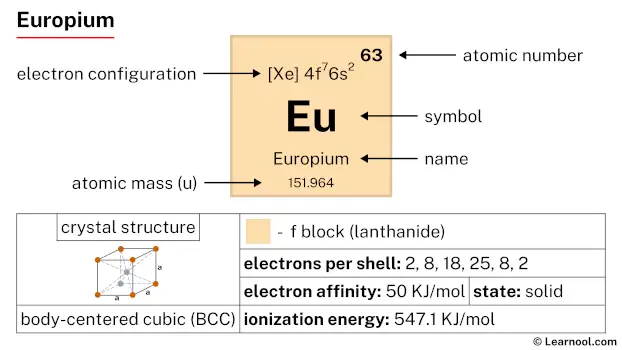 Europium |
64 Gd 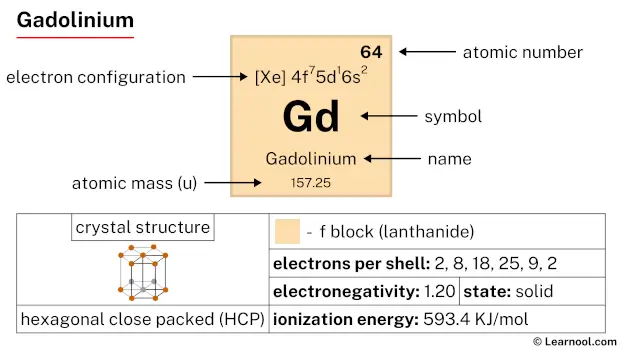 Gadolinium |
65 Tb 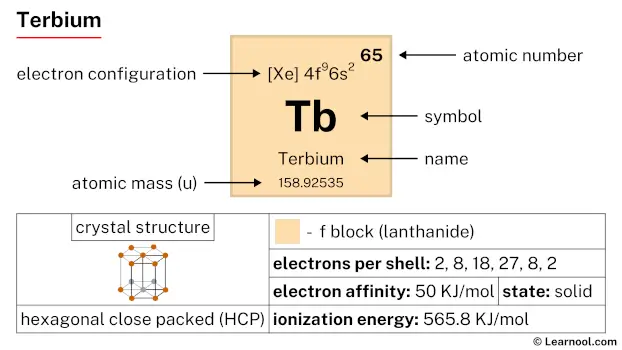 Terbium |
66 Dy 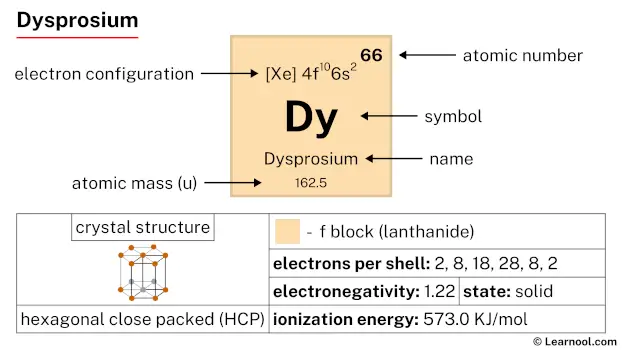 Dysprosium |
67 Ho 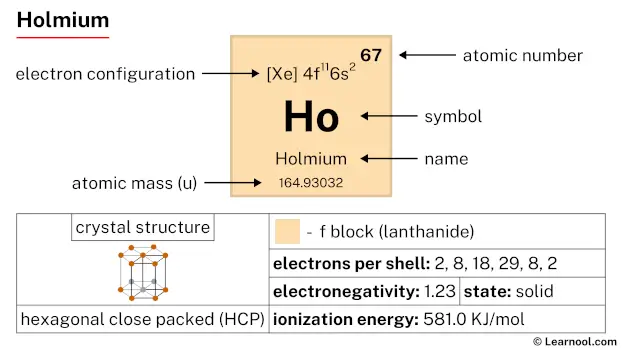 Holmium |
68 Er 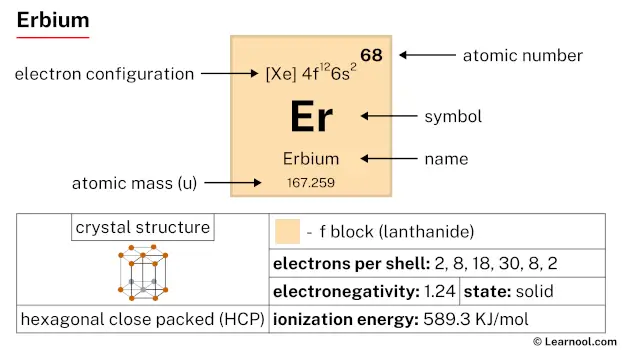 Erbium |
69 Tm 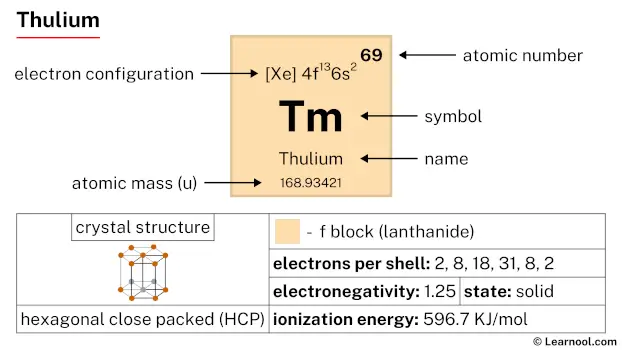 Thulium |
70 Yb 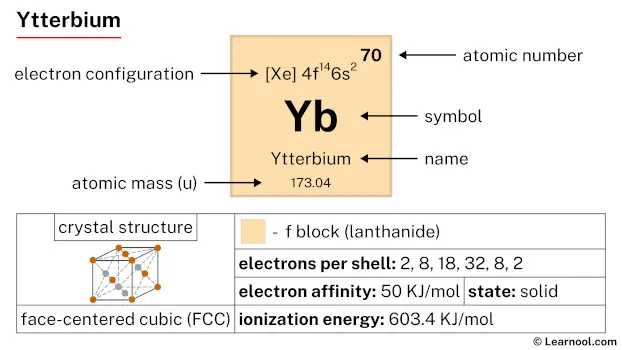 Ytterbium |
71 Lu 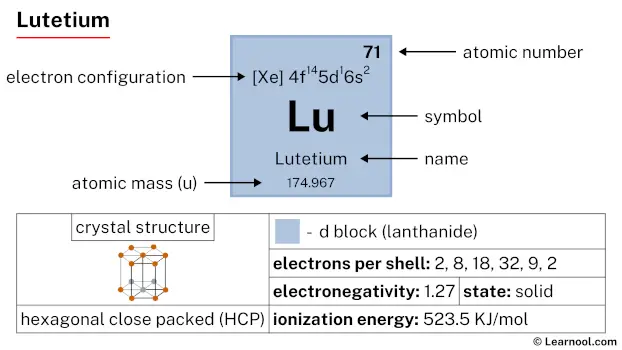 Lutetium |
|||||
| 89 Ac 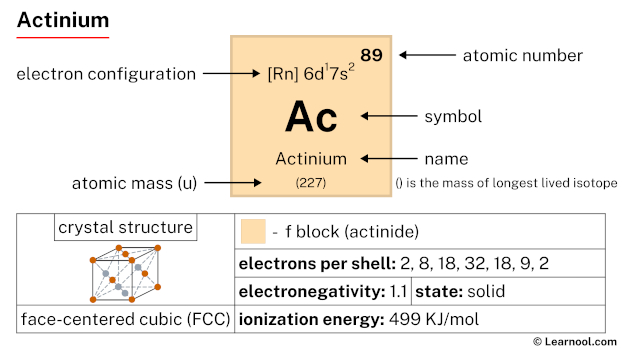 Actinium |
90 Th 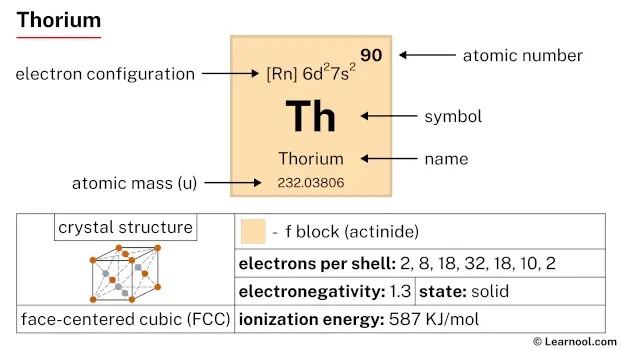 Thorium |
91 Pa 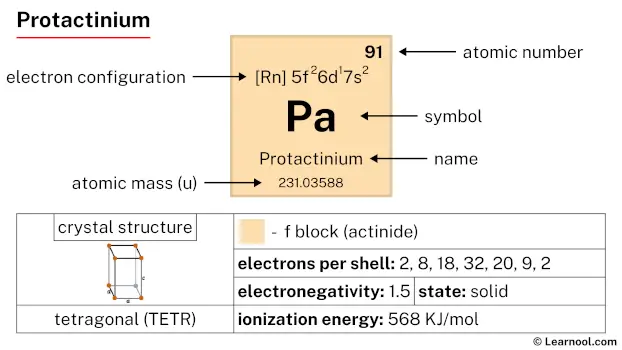 Protactinium |
92 U 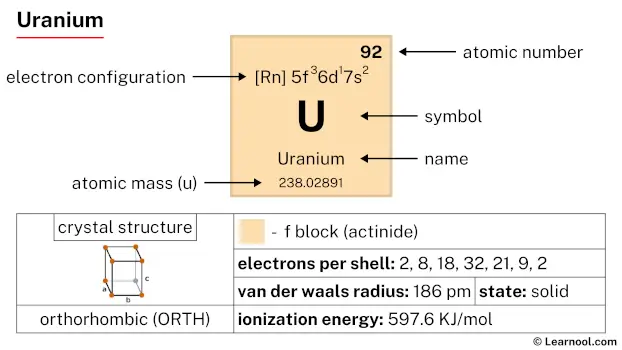 Uranium |
93 Np 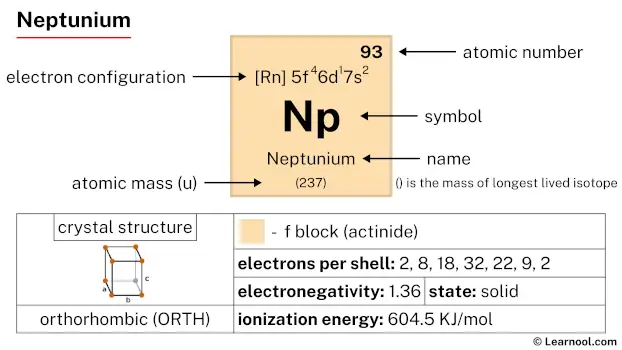 Neptunium |
94 Pu 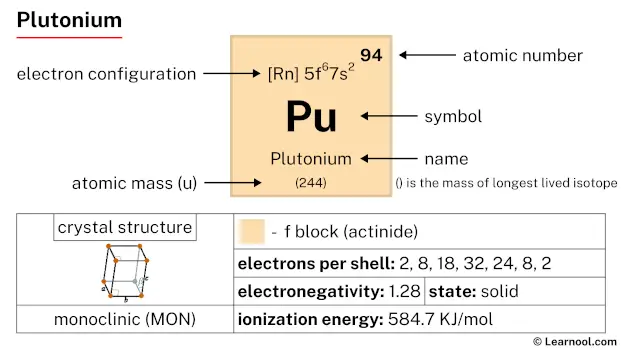 Plutonium |
95 Am  Americium |
96 Cm 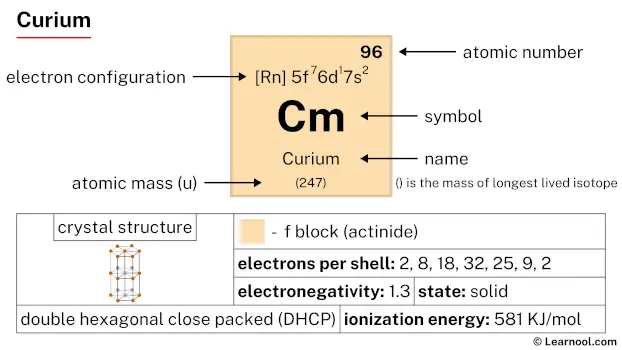 Curium |
97 Bk 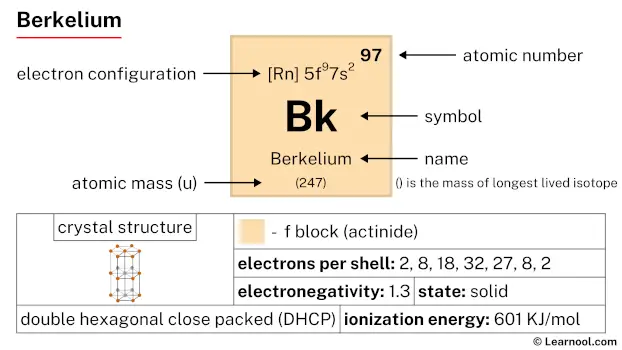 Berkelium |
98 Cf 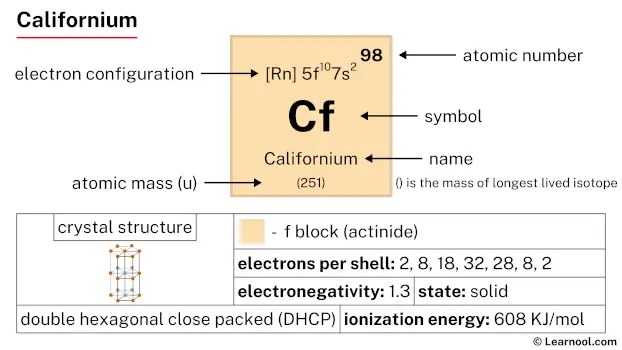 Californium |
99 Es 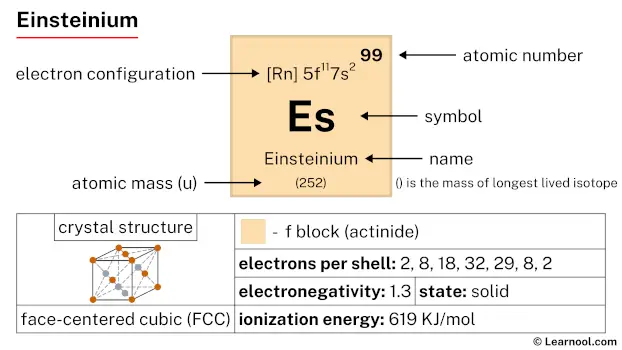 Einsteinium |
100 Fm 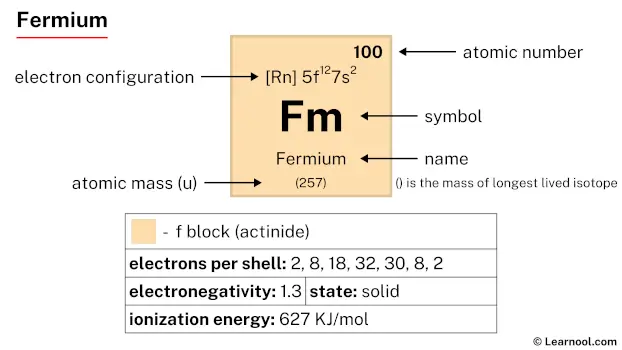 Fermium |
101 Md 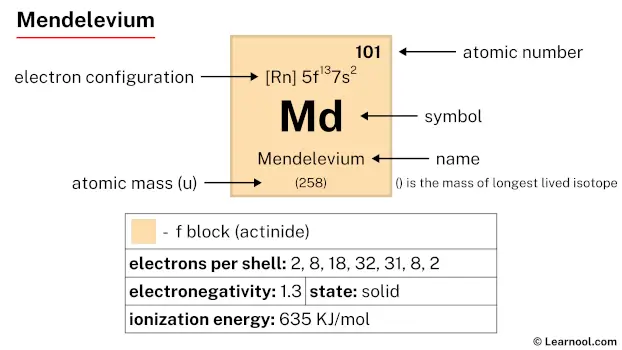 Mendelevium |
102 No 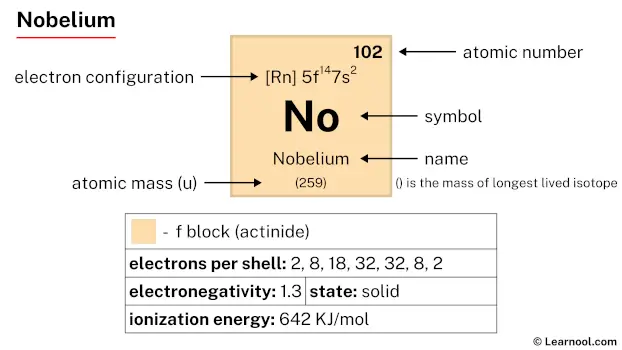 Nobelium |
103 Lr 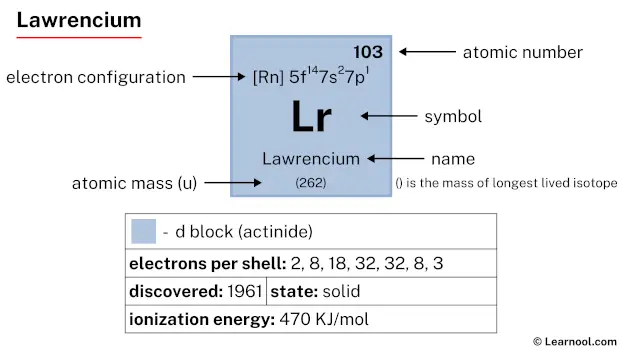 Lawrencium |
|||||
| – p block |
Bismuth is a p-block element, found in the fifteenth column (nitrogen group) and the sixth row of the periodic table. It has the atomic number 83 and is denoted by the symbol Bi.
Element information
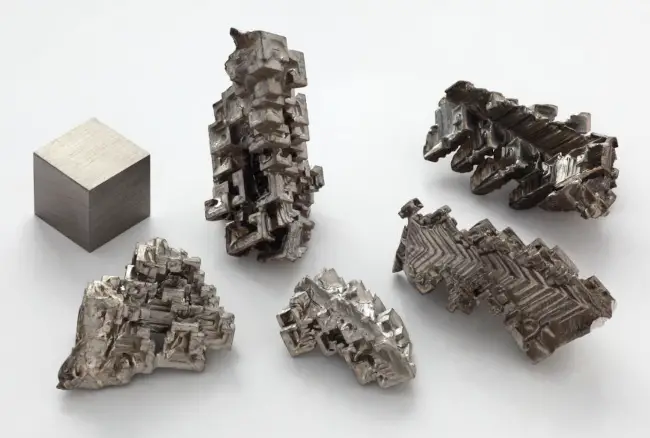 |
|
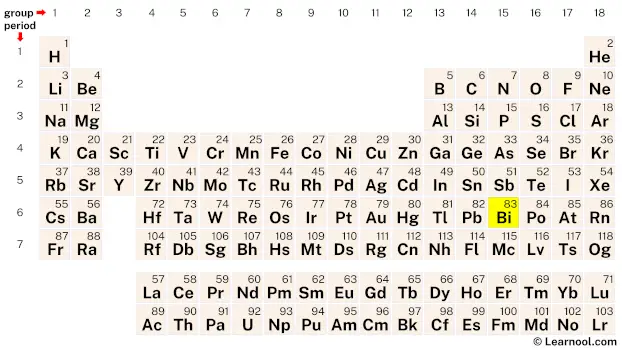 |
|
| Origin of name | German word “wissmuth” (which means white mass) |
| Symbol | Bi |
| Atomic number (Z) | 83 |
| Atomic mass | 208.9804 u |
| Block | p-block |
| Group | 15 (nitrogen group) |
| Period | 6 |
| Classification | Post-transition metal |
| Atomic radius | 156 pm |
| Covalent radius | 148±4 pm |
| Van der Waals radius | 207 pm |
| Melting point | 271.5 ℃, 520.7 ℉, 544.7 K |
| Boiling point | 1564 ℃, 2847 ℉, 1837 K |
| Electron configuration | [Xe] 4f14 5d10 6s2 6p3 |
| Learn how to write: Bismuth electron configuration | |
| Electrons per shell | 2, 8, 18, 32, 18, 5 |
| Learn how to draw: Bismuth Bohr model | |
| Crystal structure | Rhombohedral |
| Phase at r.t | Solid |
| Density near r.t | 9.78 g/cm3 |
| Natural occurrence | Primordial |
| Oxidation state | +3 |
| Electronegativity (Pauling scale) | 2.02 |
| Protons Neutrons Electrons |
83 126 83 |
| Learn how to find: Bismuth protons neutrons electrons | |
| Valence electrons | 5 |
| Learn how to find: Bismuth valence electrons | |
| CAS number | 7440-69-9 |
| Discovered by | Arabic alchemists before AD 1000 |
History
Bismuth has been known since ancient times, although its distinct properties and composition were not fully understood until much later. Due to its resemblance to other metals like tin and lead, bismuth was often confused with these elements in early times.
The exact discovery of bismuth is not attributed to any one person, as it was likely discovered by multiple civilizations independently. The ancient Egyptians, Greeks, and Romans all used bismuth compounds for medicinal and cosmetic purposes. However, it wasn’t until the 15th century that the element was identified as a distinct metal.
Georgius Agricola, a German mineralogist and metallurgist, is often credited with recognizing bismuth as a unique metal. In his book “De Natura Fossilium” published in 1546, he described bismuth as a distinct metal in the same family as tin and lead, based on his observations of the metals’ physical properties.
Throughout the centuries, bismuth has been used for a variety of purposes. In the 18th century, it was used to produce alloys for printing presses. In the 19th century, it became a popular ingredient in cosmetics, and was also used in the manufacture of fusible alloys, which melt at low temperatures and are used in automatic fire sprinkler systems. Today, bismuth is still used in a variety of applications, including pharmaceuticals, cosmetics, and electronics. It is also used as a replacement for lead in some applications, as it is less toxic and more environmentally friendly.
Occurrence
Bismuth is a relatively rare element, ranking 69th in abundance in the Earth’s crust. It is typically found in small quantities in various minerals, including bismuthinite, bismite, and cosalite. The largest deposits of bismuth are found in Bolivia, Peru, Japan, Mexico, and Canada. In addition to natural deposits, bismuth is also a byproduct of lead, copper, tin, and tungsten refining.
Production
Bismuth is primarily produced as a byproduct of the refining of other metals. The majority of bismuth production comes from the treatment of lead and copper ores. Bismuth can also be extracted from tin and tungsten ores. The refining process typically involves a series of steps, including roasting, smelting, and refining, to produce pure bismuth metal.
Another method for producing bismuth is through the electrolysis of bismuth salts, such as bismuth nitrate or bismuth chloride. This process involves dissolving the salt in water and passing an electric current through the solution, which causes the bismuth ions to move toward the electrode of opposite charge. The bismuth ions then gain electrons at the electrode, forming bismuth metal.
Bismuth can also be produced by reducing bismuth oxide with carbon or hydrogen gas at high temperatures. This method is less common than the electrolysis and refining processes and is typically only used for producing small amounts of bismuth or for laboratory purposes.
Properties
Bismuth is a post-transition metal and is the heaviest element in the group of elements that are typically regarded as metals.
It has a silvery-white appearance, but its surface can take on a pinkish tint due to oxidation.
Bismuth has a relatively low melting point of 271.5 ℃ and a boiling point of 1564 ℃, which makes it useful in alloys that melt easily.
It has a high electrical resistance, which makes it useful as a component in some electronic devices.
Bismuth is diamagnetic, meaning that it has no magnetic field of its own and is not attracted to magnets.
When bismuth is exposed to oxygen in the air, it forms a thin layer of oxide on its surface that protects it from further corrosion.
Applications
Pharmaceuticals
Bismuth subsalicylate is an active ingredient in various antacid and antidiarrheal medications due to its ability to reduce inflammation and irritation in the stomach and intestines.
Cosmetics
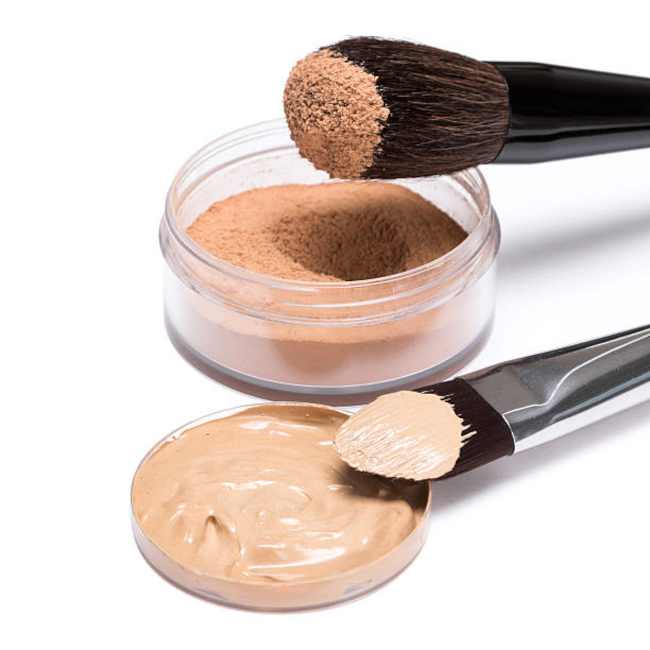
Bismuth oxychloride is used as a cosmetic ingredient in foundations, powders, and other products due to its ability to create a smooth and silky texture and give a pearlescent appearance.
Alloys
Bismuth is commonly used as an alloying agent in a variety of alloys, including fusible alloys, which have low melting points and are used for soldering, casting, and other applications.
Nuclear industry
Bismuth has a high capacity to absorb neutron radiation, making it useful as a shielding material in nuclear reactors and other applications.
Fire sprinklers
Bismuth-containing alloys are used in fire sprinklers due to their low melting point, which allows them to fuse and block the flow of water in the event of a fire.
Other applications
Bismuth is also used in the manufacture of certain types of glass, as a substitute for lead in some applications, and in certain types of semiconductors and thermoelectric devices.
Interesting facts
Bismuth is the most naturally diamagnetic metal, meaning it repels both north and south poles of a magnet.
Bismuth has the lowest toxicity of all the heavy metals, making it a safe alternative to lead in many applications.
Bismuth has a unique property of expanding as it cools, which makes it useful in some types of fire sprinklers.
Bismuth is often used as a substitute for lead in shot, bullets, and fishing sinkers due to its low toxicity and similar density to lead.
Bismuth is often added to cosmetic products such as lipstick and eye shadow for its pearlescent effect.
Bismuth has a relatively low melting point of 271.5 ℃, making it easy to melt and cast into various shapes and forms.
Bismuth has been used in traditional Chinese medicine for centuries, believed to treat digestive disorders and ease fever and inflammation.
Bismuth is a poor conductor of electricity and has a high electrical resistance, making it useful in some electronic devices and thermal fuses.
Related
More elements
External links
- https://www.rsc.org/periodic-table/element/83/bismuth
- https://en.wikipedia.org/wiki/Bismuth
- https://www.britannica.com/science/bismuth
- https://www.chemicool.com/elements/bismuth.html
- https://pubs.acs.org/doi/10.1021/acs.inorgchem.0c00222
- https://chemistrytalk.org/bismuth-element/
- https://pubchem.ncbi.nlm.nih.gov/element/Bismuth
- https://www.livescience.com/39451-bismuth.html
- https://education.jlab.org/itselemental/ele083.html
Deep
Learnool.com was founded by Deep Rana, who is a mechanical engineer by profession and a blogger by passion. He has a good conceptual knowledge on different educational topics and he provides the same on this website. He loves to learn something new everyday and believes that the best utilization of free time is developing a new skill.
